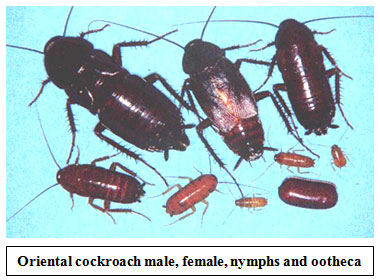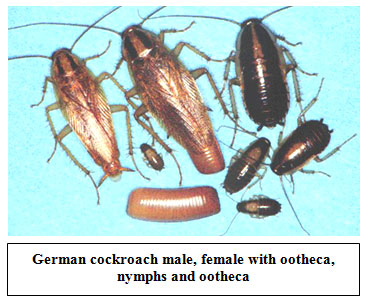How To Choose The Right Cockroach Control Products
If you have cockroaches in your house, the last thing you
want is for them to set up home in your kitchen. You want to make sure that you
get rid of them as quickly as possible through pest control products so they
can’t continue to reproduce—otherwise you’ll have a full-blown infestation on
your hands in no time.
But what exactly can you do? Well, the truth is, there are a
number of different products that you can choose from to take care of cockroaches
and the most important thing is making sure that you look at your options to
choose the right one for your needs and ensure workable pest management.
Checking Out The Options
There are different types of insecticide that you can choose
from and they tend to come in a variety of different forms. A whole host of
pest control products for effective pest management, such as boric acid, gel
baits, glue traps, powders, liquid sprays, bait stations, and active
ingredients that work like food poisoning to put in things they will be
attracted to which can destroy the adults, nymphs, and their egg cases.
The key is making sure you know which ones work for the type
of insects you’re trying to exterminate, where you want to put them and the
animals or children that you have in your home. After all, you want to make
sure that your family is protected in every way possible and insecticides can
definitely be dangerous if not treated in the right way.
Liquid Insecticides
One thing they have in common is that they need to be
sprayed close to the foundation but not right at the foundation because this
helps to create an actual barrier rather than just the wall of your house. They
should also be sprayed along windows or other edges to improve the strength of
the barrier itself.
Cockroaches
Cockroaches are not only undesirable pests but a threat to
human health by consuming our food and contaminating the indoor environment.
Cockroaches are known to transfer disease pathogens, such as
the various bacteria that produce “food poisoning” in humans, by contaminating
food, food preparation surfaces, dishes and eating utensils. How many human
gastrointestinal disorders are attributed to the mechanical transmission of
pathogens by cockroaches has not been fully assessed, but remains a valid
health concern. However, the roach’s greatest impact on human health may be its
ability to trigger asthma. Cockroach nymphs grow by periodically shedding their
“skin” (the exoskeleton). Fragments of their exoskeletons, along with bits of
cockroach feces, serve as antigens (foreign protein) that, when inhaled, cause
allergic and asthmatic reactions.
Several species of cockroaches live inside structures. Most
domestic cockroaches are of tropical origin and the German cockroach, for one,
cannot survive temperate winters outdoors. All are primarily nocturnal. All
prefer warm, moist places where they can feed on human and pet foods, decaying
and fermenting matter, and a variety of other items
GERMAN COCKROACH
The German cockroach (Blatella germanica) is by far the most
common roach found in kitchens. It is a half-inch long, bronze-colored insect
that avoids light and hides in cracks and crevices. Adults and older nymphs
have two black stripes on the back just behind the head.
ORIENTAL COCKROACH
The Oriental cockroach (Blatta orientalis) is the so-called
“waterbug” of basements, crawlspaces and garages. It lives in cooler habitats
with plenty of moisture – even outdoors around foundations in leaves and mulch
where it can survive temperate winters. As a result, the Oriental cockroach’s
development is slower. They require an average of 18 months to progress from
egg to adult, while the German cockroach averages only two months to adulthood.
In addition, the Oriental’s egg case contains 16 eggs, compared to the German’s
30 to 48 eggs per case. After being detached from the female, eggs inside the
Oriental roach’s egg case require an average of two months to hatch
HOW TO DETERMINE WHAT TYPES OF COCKROACHES ARE IN YOUR HOME
There are more than 4,500 different types of cockroaches,
but only 69 species are found in the U.S. Learn how to spot signs of
cockroaches in your home
There are more than 4,500 types of roaches in the world, of
which only around 69 species are found in the United States. And while that
number is still pretty high, the good news is you really only have to worry
about five or six different roach species, depending on which state you call
home. Most species of roaches rarely invade homes, including the western wood
cockroach and the brown-hooded cockroach (which prefers to live outside in the
Pacific Northwest)
But the news isn’t all good. These handful of troublesome
roach species that want to move in with you can easily become a nightmare for
any homeowner. Consider that for every roach you can see, there’s a good chance
there are dozens, even hundreds, in your home that you can’t see. And while all
roaches might look the same as they scatter when you turn on the lights,
knowing how to tell the difference between the most common types of roaches in
your home will help you choose the most effective pest control methods to stop
the infestation dead in its tracks
General appearance of all types of roaches
First, be certain you are actually dealing with cockroaches.
Roaches can be mistaken for other insects such as grasshoppers, beetles or
crickets. Cockroaches have flattened, broad bodies with long antennae and long
hind legs. Each of their six legs has tiny sensory hairs. Adult roaches have
wings that fold flat on their backs, but not every cockroach can fly. Most
roaches are brown or black and can range anywhere from 0.07 inches to 3 inches
in length, depending on the species.
German cockroaches
The German cockroach is the most common of all cockroach
types found in America. Their high-speed capacity for breeding makes them a
direct threat to your family and home. All it takes is one single female to get
into your home. Between her and her offspring, more than 30,000 cockroaches can
be produced in one year, though many of them won’t live very long. The ones
that do survive are more than enough to cause disease and disgust. Each German
cockroach egg case (ootheca) can hatch between 20 and 40 baby roaches, and
unlike other types of cockroaches, the adult female carries the eggs with her
until they are ready to hatch. This makes them extremely persistent and
difficult to get rid of.

A How-To Guide on Controlling Cockroaches at Home
Have you ever wandered into the kitchen for a late-night
snack, only to scream in horror as you glimpse a cockroach stealing away into
another room? If so, you’ll probably want to know what you can do to make sure
this doesn’t happen again. We interviewed Steve Durham, founder and co-owner of
EnviroCon Termite & Pest, Inc., in Houston, Texas, to learn more about
these ancient nuisances and how to keep them out of your home.
What Do I Need to Know About Cockroaches?
Why are cockroaches so ubiquitous? What is unique about
them?
Cockroaches are omnivorous. Their ability to eat any food
source makes almost any locale a potential feeding site. Although members of
the order Blattodea (the scientific name for cockroaches) are found worldwide,
individual families within this order are segregated into different regions
that they’re best suited for. Other insect orders are similar in nature. Take
Diptera for instance—flies and mosquitoes are just as widespread.
How prevalent are different types of cockroaches in the
North versus the South?
German cockroaches are found in both regions because they
prefer indoor habitats. American cockroaches are found in both regions because
they prefer the warm, moist conditions found in storm drains and utility
tunnels. Exterior-dwelling roaches, like the Surinam or Australian cockroaches,
are more prevalent in southern regions due to the warmer habitats.
How can a homeowner tell the difference between a rogue
cockroach here or there and a legitimate problem that requires further action?
Population density and the specific species will determine
the best and most economical form of treatment. It’s normal for one or two
American or Smokybrown cockroaches to enter a structure now and then and not be
a problem. They prefer to live outside the home environment, so if you see one
or two of them, it’s normally an accidental invasion into the home.
How Do You Get Rid of Cockroaches?
What preventative measures/practices can a homeowner employ
to help a cockroach-free home stay that way?
Sanitation is the key! A breadcrumb dropped behind a stove
can feed roaches for weeks. Add to this grease splatter from frying, other tiny
bits of food that children drop, and the availability of water in a kitchen,
and you have a perfect habitat for roach rearing.

Cockroaches: The insect we’re programmed to fear
Why are we so revolted by roaches? Rachel Nuwer visits her
own personal insect hell to find out, and discovers a disturbing truth about
our future with these creatures
what’s your earliest memory? For me, the answer is not
pleasant.
I’m about four years old, and I’m sitting in the
green-carpeted hallway of our family’s first home in Biloxi, Mississippi. The
bathroom door stands open in front of me, and my mother is emerging from the
shower. As she pulls a towel from the rack, I notice a dark stain marring that
clean, fluffy pink material. It’s a cockroach. I see it before she does. As she
wraps the towel around her body, however, it quickly makes itself known. She
shrieks, flailing and stomping, suddenly naked and vulnerable and afraid. I
begin to cry
I recently asked my mother about this event, and she had no
idea what I was talking about. Perhaps I dreamed it, or my early memory is
flawed. Or perhaps it was just business-as-usual in our Southern US home, where
– no matter what chemical barriers were erected – cockroaches inevitably found
their way inside
Real or imaginary, this incident triggered an intense
dislike of cockroaches that would only intensify as years passed and encounters
with those creatures multiplied. For me, a roach is not just an insect. It is a
psychological gateway into a lengthy laundry list of traumatic experiences:
digging through a box of supplies in my outdoor playhouse when a roach zips out
and scuttles up my leg, its spiky appendages pricking at my skin. Watching my
first cat, Salty, as he traps a roach, dismembers it with his claws and mouth,
and then eats the succulent, writhing remains. Finding a small dead cockroach
tangled in my wet hair after a trip to the beach, and thereafter suffering
recurring nightmares of picking roaches out of my hair.
Roaches invade our homes and make those intimate spaces
their own. As physical embodiments of filth and germs, they show that for all
of our fortifications against dirt and disease, those efforts are ultimately
futile. “They’ve really figured out how to exploit the opportunities we create,
and in doing so, developed behaviours and life histories that prevent us from
controlling them,” says Jeff Lockwood, a professor of natural sciences and
humanities at the University of Wyoming. “In a sense, we loathe that which we
foster.” Our very existence enables them to thrive